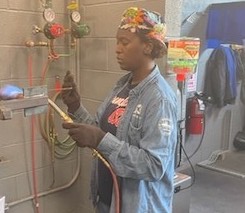New York, NY – Steamfitters Local 638 maintains jurisdiction over all general pipe fitting in New York City, including all five boroughs and all of Long Island, Nassau and Suffolk Counties — and is a combination local union representing the Construction Branch and the Metal Trades Service Branch.
Steve Cuadra is Director of Education at the local’s training program. He joined the union right out of high school and is now celebrating his 42nd year at the local. LaborPress spoke to him about the training program’s requirements, what apprentices learn, and how the program strives for inclusivity.

LP: What are some of the requirements to be accepted into the apprentice program?
SC: High school graduate, pre-employment drug test. We don’t ask for any other kinds of certifications. You have to remember, you’re coming in as an apprentice, so apprentices really don’t know much, so that’s why we teach them. As far as the physical, it’s a physically demanding job. We do ask them in the interview process: Are you afraid of heights? Are you okay working off a ladder? You know, it’s the construction industry, you could be working out in the cold and in the winter. You okay with that? And you’ll be working in a boiler room in the middle of summer. Are you okay with that? Stuff like that.
LP: How long is the training program and what does it involve?
SC: We’re in a five-year program. School one day every other week during the day. If you are working, according to our collective bargaining agreement, the employer must pay you for seven hours’ worth of work wages. Basically, you’re coming in to school and you’re getting paid. But of course, you have to be working for a contractor. If you’re not working, if you’re unemployed, then there’s nobody to pay you, so you don’t get paid. Each year we focus on different things. Obviously, with our industry welding is emphasized a lot because it’s a huge part of our business. [Apprentices] start welding in the second year, third, fourth and fifth year, and then they get other related instruction.
Obviously, safety is a huge part of our business. So, before they even go out into the field, they need to get their site safety training card. If you wanted to work pretty much on any construction site in the five boroughs in New York City, you must have what they call a site safety training card. And in order to obtain that card, you have to do 30 hours of OSHA training, an additional 10 hours which would include eight hours of fall prevention. They emphasize fall prevention because, as we all know, falls are the biggest killer on construction sites. [Apprentices] also have to do two hours of drug and alcohol awareness for a total of 40 hours, and then you can obtain your site safety training card. Some other certifications they might need are torch use and fire watch — those are certifications issued by the Fire Department in New York. [Apprentices] would have to go down to Nine Metro Tech and take a test and get those two certifications. Then we have other ones, scaffold training…we have a rigging class that we do with the guys and girls. But we don’t do the rigging class until the fifth year on their way out. Some people can be test-takers and pass a rigging test and you put them out in the field and they’re lifting a piece of heavy equipment and they can hurt themselves or hurt somebody. That’s why we wait for the end of the fifth year to get them that. And then the first year we try to get them into the pipe shop to learn to use the threading machines because they’re dangerous machines to operate. The first year is a lot of theory. [Apprentices] do spend a lot more time in the classroom than they do the second, third, fourth and fifth year. Second year they get the fire sprinkler classes. They’re in the copper shop, copper connections class, on how to connect copper, different ways of connecting copper. We introduce them into the weld shop in the second year. Third year, they’re welding again — like I said it’s a big emphasis. They do steam technology classes, refrigeration classes, drafting blueprint reading, hydonics classes. They can choose to get their CFC certificate certification, that’s a test administered by the EPA to handle refrigerants.
LP: What does the program do to increase diversity, equity, and inclusion?
SC: We have an open recruitment. Right now, we’re working off a rank list that was turned over to the New York State Department of Labor. So we work off of that list. And we do a recruitment every three to four years, and then we do that process all over again. So, we are very diverse. Also, we use direct entry programs. We use five direct entry programs. [Some of them are] Helmets to Hardhats, Opportunities Long Island, Construction Skills 2000, and NEW, Non-traditional Employment for Women.
LP: What is the future of the industry, especially in terms of changing technology? And how are you preparing for that?
SC: The technology’s changing as we speak. Geothermal systems have become very, very popular. They have a high efficiency rate. There’s no carbon footprint whatsoever. It uses the Earth’s energy to transmit heat. So, that technology is coming — and it’s coming real fast. Our International Union, the United Association is pushing the geothermal in the state. New York is at the forefront of geothermal technology. So, that’s what’s coming down the road. We do have a partnership with the United Association and they offer grants for certain types of equipment that we can use to train our members. So it’s here.


